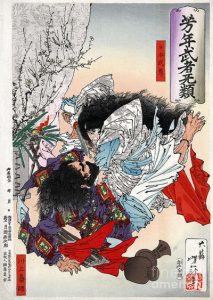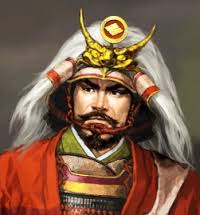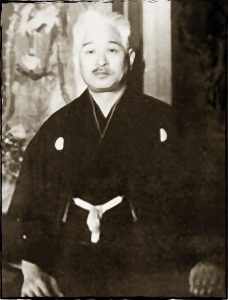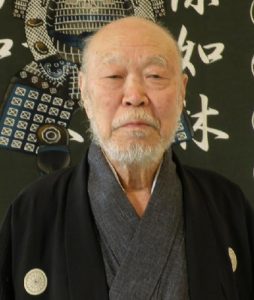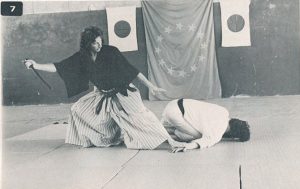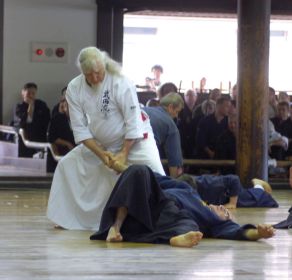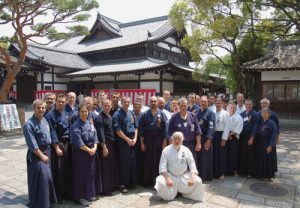HISTORY AND TRADITION OF TAKEDA-RYU |
This is an overview of the history of Takeda Ryu. The study of history is in important part of the Way. Through history we learn to appreciate those who came before us and dedicated their lives to the preservation of Takeda Ryu. We realize that our study is not entirely about ourselves, but about the continuation of the teaching. Then, a wish to embody the tradition to the best of our ability may arise, enriching our practice and elevating our spirit.
The article is divided into four parts: Genealogy of Takeda Ryu, Takeda Ryu Nakamura-Ha, Takeda Ryu Maroto-Ha, Spirit of Takeda Ryu in words of master Maroteaux.
That being said, please keep in mind, that further down history we go, the more metaphoric it becomes. Earliest records of the school are largely mythical. It is also typical to make one´s school look great by associating it with a famous figure or an event, even though it had nothing or little to do with it. Unfortunately, due the inability to obtain handscrolls pertaining to the history of Takeda Ryu, the information we present derives from secondary sources.
Japanese terms are written in cursive first time they are used, personal names follow traditional order: surname and first name.
This article was put together by Radim Smolka (2. Dan Iaido TRMH).
Sources:
WATATANI, Kyoshi; YAMADA, Tadashi. Bugei Ryuha Daijiten. Shōwa era (1979), pages 534-535; 54.
Généalogie [online]. takedabudo.com [quoted on 14th April 2023]. Accessible at <https://www.takedabudo.com/%C3%A0-propos-1>.
MAROTEAUX, Roland J. Aiki-jujutsu Takeda-Ryu Maroto-Ha (Du Débutant Au 1 Kyu). Avignon: marotoédition, 2016. Pages 9-13.
MAROTEAUX, Roland. J. Iaido Takeda Ryu Maroto Ha (Du Du Débutant Au 5 Dan). Avignon: marotoédition, 2013. Page 15.
NAKAMURA, Hisashi. History of Nihon Aikido Renmei and its progress. Published by Seibido Shuppan in 1987, pages 25-34 (translated from japanese by Takami Kachi). Accessible online at <https://www.takedabudo.com/%C3%A0-propos>.
Takeda Ryu Nakamura Ha [online]. Wikipedia.org [quoted on 14th April 2023]. Accessible at <https://en.wikipedia.org/wiki/Takeda_Ryu_Nakamura_Ha>.
Budo Institut – What is Takeda Ryu Nakamura Ha? [online video]. youtube.com [watched on 14th April 2023]. Accessible at <https://www.youtube.com/watch?v=u-pqlNSZUmk>.
MAROTEAUX, Roland J. Who is master Maroteaux? [online]. takeda-ryu.net [quoted on 14th April 2023]. Accessible at <http://www.takeda-ryu.net/crbst_19.html>.
MAROTEAUX, Roland J. Teaching and Particularities [online]. takeda-ryu.net [quoted on 14th April 2023]. Accessible at <www.takeda-ryu.net/crbst_24.html>.
MAROTEAUX, Roland J. The Spirit and the Technique [online]. takeda-ryu.net [quoted on 14th April 2023]. Accessible at <http://takeda-ryu.net/crbst_34.html>.
Genealogy of Takeda Ryu
In the 27th year of the reign of the twelfth tenno (emperor) by the name of Keiko (Keigyo), the Kumaso tribe rebelled. As a result, the heir to the throne, Yamato Takeru no Mikoto, was sent on an expedition to punish the Kumaso. On his way, he performed a cleansing ceremony at Kamiyo waterfall. He placed his feet on the rocky floor of the waterfall, spread his arms wide, was filled with the power of the spirit and gathered the entire strength of his body in his fingertips. Turning towards heaven, he executed several upward blows, then let his hands drop and struck out powerfully several times with his arms. After the prince had completed these movements, he decided to attack the Kumaso. Disguised as a woman, he crept into the enemy´s camp and there roused the sleeping leader of the Kumaso. When the leader tried to attack him, the prince opened his arms, was filled with spiritual strength and threw the leader to the ground, having already snatched his sword from him. This technique of spreading one´s arms and throwing down one´s opponent was the beginning of Aiki. Thereafter, the prince studied diligently and passed on his skills to Takeda no Kimi no Mikoto for the protection of the palace.
Ever since, Yamato Takeru no Mikoto was considered as the first taiso (ancestor) of the Takeda school. At that time in history, it was not named Takeda Ryu. Later the knowledge of the school passed on to the famous general Shinra Saburo Minamoto no Yoshimitsu. Since that moment the school is associated forever with the name of the Minamoto, which was one of the noble surnames bestowed by the Emperors of Japan upon members of the imperial family who were excluded from the line of succession and demoted into the ranks of the nobility. This connection can be seen in the names, which soke (head of the school) Nakamura awards to his highest masters. Roland J. Maroteaux received the name Minamoto no Maroto from soke Hisashi Nakamura on April the 10th 1988, and in turn master Maroto bestowed the name on his senior students Serge Charlopeau (Minamoto no Syaropo) and Christian Barnavol (Minamoto no Baruna). Another visible connection with the imperial family is the mon (logo) of Takeda Ryu. Regardless of the branch, the mon consists of Japanese imperial chrysanthemum petals.
Image: Yamato Takeru no Mikoto
Minamoto no Yoshikyo (1075-1149), the son of Yoshimitsu, went to Kai Province and resided at Ichikawa no sho estate. The descendants of Yoshikiyo settled in various places in Kai province, and became the Kai-Genji. Kai is from Kai Province, and Genji is the Chinese reading of Minamoto. Yoshikyo then founded the Takeda line, also known as Kai Genji Takeda, and called himself Takeda Yoshikyo. He was the first to summarize the martial techniques of his father, he
is therefore considered the first soke of Takeda Ryu.
Until soke Takeda Nobutora (with the school’s name Tokushusai) Takeda Ryu stayed within the Takeda family. In 1570 he passed on his knowledge to his ninth son Takeda Kouzukenosuke Nobutomo (with the school’s name Ousai). About ten years later Nobutora was thrown out of the Takeda family by his son Takeda Shingen, one of the most famous generals in Japan’s history. Nobutora went to Suruga to submit to the daimyo (feudal lord) Imagawa Yoshimoto. On the other hand, Takeda Kouzukenosuke Nobutomo passed his knowledge over to his first son Takeda Katsuchyo, who moved to the main island of Kyushu to the Kuroda family, because he was afraid of being killed by Shingen. He started to teach Takeda Ryu in secret, which assured the survival of the school. This line is known as genryu, the original line (in contrast with lateral line of Daito ryu, called shuryu).
Image: Takeda Shingen
Oba Ichio (1899-1959, his real name was Oba Takeyuki) practiced Judo and Kendo during his studies of foreign languages in Osaka and later at the Meiji University in Tokyo. During those years in Tokyo, he came in contact with Nakamura Kichio, a leading member of the Kokuryukai (Black Dragon Society, paramilitary ultranationalist group) and the 42nd soke of Takeda Ryu since 1911 after having been trained in the Genyosha (Black ocean society, Pan-Asianist ultranationalist group) by Takeda Tadakatsu, the 41st soke of Takeda Ryu. In 1935, Nakamura died and Oba became his successor, the 43rd soke of Takeda Ryu. In the 20th year of the reign of Showa (1945), Oba Ichio started to teach Takeda Ryu in public. Until that time the teaching had been in secret. After the Second World War master Oba was adviser at the Ministry for Foreign Affairs, after he successfully finished the world-famous Meiji University. Soke Oba Ichio was also the holder of the menkyo (license) from the Houen Ryu, Kukishin Ryu and the Shito Ryu.
Photo: Oba Ichio
The genryu of Takeda Ryu ended in 1959 with the death of soke Oba Ichio, because Moritomo Kazuo, who was appointed as a successor, declined the position. Thankfully, because of Oba´s student Nakamura Hisashi the teaching of Takeda Ryu survived to this day through the creation of Takeda Ryu Nakamura Ha. This branch also served as a basis for new schools created by Nakamura´s students, namely Roland J. Maroteaux (Takeda Ryu Maroto Ha, which we study) and Siegfried Kobilza (Takeda Ryu Kobilza Ha).
Line of Takeda Ryu soke is as follows:
- Takeda Kajya Yoshikyo
- Takeda Kurogenta Kyomitsu
- Takeda Tarou Nobuyoshi
- Takeda Gorou Nobumitsu
- Takeda Kotarou Nobumasa
- Takeda Nobutoki
- Takeda Nobunaga
- Takeda Masatsuna
- Takeda Nobuie
- Takeda Tokitsuna
- Takeda Yaroku Nobumune
- Takeda Nobutake
- Takeda Gyobudayu Nobunari
- Takeda Ujinobu
- Takeda Shurinosuke Nobuharu
- Takeda Motonobu
- Takeda Tarou Nobumitsu (Tarou means first son)
- Takeda Tarou Nobushige
- Takeda Yasaburou Nobumori
- Takeda Nobusuke
- Takeda Mototsune
- Takeda Nobumasa
- Takeda Gorou Nobutsuna
- Takeda Nobutora (Tokushusai is a budo name)
- Takeda Kouzukenosuke Nobutomo (Ousai is a budo name)
- Takeda Katsuchyo
- Takeda Takeou (or “buo”) Nobukatsu
- Takeda Nobutaka
- Takeda Takayoshi
- Takeda Jiro (Jiro means second son) Kiyokata
- Takeda Gorou Nobuhide (Gorou means fifth son)
- Takeda Mitsuharu
- Takeda Nobutada Hisamiki (or “Kyukan”)
- Takeda Teruyo Kogetsuni (the only woman, the ending ni stands for a female priest)
- Takeda Hisayo Mitsunobu
- Takeda Takasumi
- Ouhara Masakatsu
- Ouhara Mitsumasa
- Takeda Masaaki
- Takeda Morinosuke (Ouatsu is a budo name)
- Takeda Tadakatsu Oudou
- Nakamura Aikisai Oukitchi Takeda
- Oba Ichio
- Nakamura Hisashi (creator of Takeda Ryu Nakamura Ha and its first soke)
- Nakamura Shuji (son of Hisashi, second soke of Takeda Ryu Nakamura Ha)
Takeda Ryu Nakamura Ha
Nakamura Hisashi was born in 1932, in Shinshu (Nagano prefecture), but moved to northern Kyushu in the autumn of 1948 to join his aunt in the city of Kitakyushu. He soon learned that there was a Takeda Ryu dojo on Mount Yagura in Nakahara, Kokura-ku. It was a school run by master Oba Ichio, 43rd soke of Takeda-Ryu. In the spring of 1950, Nakamura became a disciple of Oba.
Entering Takeda Ryu was so severe at that time that Nakamura needed two guarantors; he had to sign a contract with blood (keppan), and before being allowed to train, he had to sit on the side of the dojo and watch. The entrance rule book stated: “The dojo is not responsible for any accidents,” and “Any techniques learned at the dojo shall never be disclosed to outsiders, including the student´s family members.” Further, the tuition was very expensive. The monthly fee was a quarter of the monthly salary of the average office worker after college. Soke Oba taught only koryū waza (old techniques), which comprised hard combative techniques, without verbal explanation. Falling (ukemi) was not taught at all. At that time, the dojo comprised about a dozen students.
Photo: Nakamura Hisashi
In 1953, after being a sotodeshi (a student living outside of the dojo) for 3 years, Nakamura was finally accepted by soke Oba as uchideshi (a student living inside of dojo together with soke). Around this time, Master Oba left for Tokyo and built the Takeda Ryu Honbu Dojo called Seibuden in Matsubara, Setagaya-ku, Tokyo. Trying to promote Budo, Soke Oba organised Nihon Budo Renmei. In the autumn of 1956, since Morimoto Kazuo Shihandai (deputy instructor), who had been a deputy of Soke Oba, had to leave Takeda Ryu and return home due to family matters, Nakamura came to Tokyo to act in place of Morimoto Shihandai.
However, 3 years later, in late 1959, Soke Oba suddenly passed away due to a disease. And thereafter, Seibuden became unpopular. After the unexpected death of Soke Oba, without a successor, the line of transmission of the teaching would have ended abruptly if not for Nakamura Hisashi. This was a crucial moment for the preservation of Takeda Ryu. In the spring of 1960, Nakamura made up his mind to dedicate his entire life to the pursuit of Budo and became independent. He quickly realised that if he wanted to survive, he would have to make the teachings available to more people. Master Nakamura did it by deconstructing koryū waza, which Soke Oba taught exclusively, into kihon waza (basic techniques) and henka waza (variations), and creating a system of progression by assigning specific techniques to Kyu and Dan ranks. By doing so, Master Nakamura created a system for a modern practitioner, and yet he retained the spirit of Takeda Ryu. Thus began ten difficult but ultimately very fruitful years in which many dojos and clubs were founded, as well as Budokai, an independent organisation that was renamed Nihon Sobudo Rengokai (NSR) in 1970. It still exists today and is headquartered (Honbu Sobukan) in Tokyo. Nakamura developed a new way of teaching Aiki no jutsu and called it Aikido (not to be confused with the more common aikido of Ueshiba Morihei). On 11th February 1978, Takeda Ryu Nakamura-Ha was officially inaugurated. Nakamura Hisashi died in 2018 and was succeeded by his son Nakamura Shuji as the soke of Takeda Ryu Nakamura Ha.
Seven disciplines are taught inside the Takeda Ryu Nakamura Ha Sobudo (meaning complete martial way). These disciplines are Aikido, Jukenpo (the way of the soft fist), Iaidō (the way of quickly drawing the sword), Jōdō (the way of the short staff), Shugijutsu (the art of the short stick), Tachikendo (fencing) and Shurikenjutsu (the art of throwing spikes). Techniques are divided into kihon waza (basic techniques, practised without attacking in order to transmit the feeling of the technique), henka waza (variations from basic techniques in the form of an attack) and koryū waza (old techniques). The okuden (deepest teaching) is heihô (military strategy). The school uses shiai (competition) and randori (free-style practice) as a way of teaching. In Aikido, shiai and randori exist in two different forms. The first one is called sogo, and the second is tori waza. In Japanese, sogo means integrated. In this form of practice, opponents wear a leather glove (uchi kote) on one hand and hit freely with that hand. They are also allowed to throw and to lock. The tori waza is a technical match where opponents take alternatively the role of uke (one who receives a technique) and tori (one who applies a technique). In Iaidō, competition is called Kumi-batto-shiai, when two swordsmen face each other at a distance and compete in a series of: 1) noto kata (when ordered hajime/begin, swordsmen firstly need to noto/sheath the sword and then launch two successive attacks of their choice, but first has to be kiritsuke/one-handed and second kiri/twohanded), 2) senko kata (attacker carries out three attacks of which two are chosen by the central judge and third is a kiri of choice, and defender defends himself with two parries, again chosen by central judge, and a counter-attack of kiri), 3) kotai (changing of roles), 4) batto kata (sword is sheathed, swordsmen maintain seishintai/correct position of body and mind, when ordered hajime, both swordsmen launch two successive attacks), 5) noto kata, 6) batto kata, 7) noto kata. First to reach 4 wins is the victor; the shiai continues in case of a tie. Takeda Ryu Nakamura Ha uses two ranking systems: Kyudaho (Kyu and Dan) and Menkyo (teaching license), which have five levels: Shoden (basic level), Chuden (middle level), Joden (upper level), Okuden (secret level), and Kaiden (complete transmission).
Takeda Ryu Maroto Ha
Grandmaster Roland Jean Maroteaux was born in Chênée, Belgium, on December 12, 1944. In 1961, he discovered Judo in its traditional form with master Henry Dalbin (1926-1991), 3rd Dan. In 1963, he met Master Noro Masamichi, 4th Dan of Aikido at that time. Master Noro initiated Maroteaux into a harmonious form of body expression, combining beauty and efficiency, forming the basis of Maroteaux´s further training. In 1966, Maroteaux started Karatedo under the direction of one of the most respected experts in the world of martial arts: Master Henry Plee 10. Dan, in his dojo on the Sainte-Geneviève mountain in Paris. It is thanks to him that in 1970 he met master Dogane Takeshi, then a 4. Dan of Hakko-ryu. Maroteaux studied this form of jujutsu, still unknown in France, for three years. In 1973, he obtained the grade of 4th Dan in Hakko-ryu in Tokyo after an examination in front of Master Mimurodo Hisamitsu (1911-1985) and Master Terasawa Gozan. In 1974, Maroteaux returned to Japan to perfect his knowledge of jujutsu with master Okuyama Ryuho (1902-1987) in Omiya and came back with a master’s degree in jujutsu awarded by the Nihon Bu-jukushi-goshindo-Hakko-ryu.
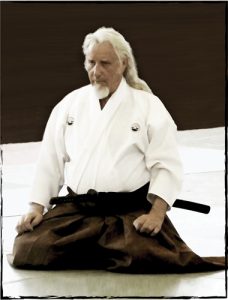
In 1986, master Maroteaux decided to re-evaluate his level and flew back to Japan, where he met Master Nakamura Hisashi, creator of Takeda Ryu Nakamura Ha, heir of the late Oba Ichio, the last soke in the Takeda Ryu lineage in Chiba. In 1987, Maroteaux invited this exceptional master to France. Soke Nakamura was accompanied by two remarkable assistants: sensei Sofue Toshihisa 8. Dan and Toyoshima Masayuki 7. Dan. In 1988, master Maroteaux received from Master Nakamura his Japanese Budoka name Minamoto no Maroto, in homage to his fidelity to the tradition. This was a way of integrating him definitively into the noble family of heirs of this ancestral school. In 1990, Maroteaux received from master Nakamura the Densho (Menkyo-jo) of Joden Shihan in Takeda Ryu and the grade of 5. Dan Aikido, 5. Dan Iaido, 5. Dan Jodo, in the presence of the Consul General of Japan, held the ceremony took place in France. In 1993, at the end of the first European Takeda Ryu Nakamura Ha congress held in Chartres, Master Nakamura raised Maroteaux to the rank of 6th Dan in Aikido.
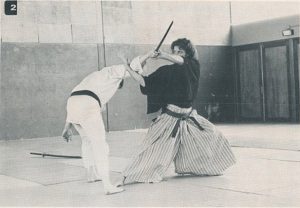
Photos: Demonstration of Takeda Ryu art
On September 1, 1997, Maroteaux created his own teaching method under the name Marotokan, based essentially on intuition, spontaneity, and improvisation. In order to distinguish himself from other existing schools, he named his group Takeda Ryu Maroto-Ha on December 20th, 1997. Takeda Ryu Maroto Ha comprises seven disciplines: Aikijujutsu, Iaido, Tachikenjutsu, Jukenpo, Jodo, Shugijutsu, and Shurikenjutsu. Its curriculum consists of kihon waza, henka waza, and koryū waza, drawing from Takeda Ryu Nakamura Ha. Apart from awarding Kyu and Dan, as well as teaching licenses, master Maroteaux also awards honorific titles of Sensei, Renshi, Kyoshi, Hanshi-ho, and Hanshi. A major specific of Takeda Ryu Maroto Ha Aikijujutsu is the inclusion of Aiki-goshindo-waza (self-defence techniques), which derives from master Maroteaux´s extensive knowledge of jujutsu.
Other specifics of the Marotokan teaching method are as follows:
– The guard is always right foot forward, according to the posture of the Japanese swordsmen of the past. This does not mean that one defends oneself on one side only.
– The basic techniques (kihon waza) do not include any form of attack and are practised on the right and left while changing the guard, since it is, above all, about education.
– All empty hand techniques are very old and were practised in the past on the battlefields. They are specific to the Takeda Ryu.
– The study of atemi (strikes to specific points on the body) with the cutting hand is commonly practised. Contact training is done while wearing a special glove (Sogo).
– In application, most of the techniques end with immobilisation on the ground in the form of arm, elbow, or wrist locks, which are called Aiki-goshin-jutsu-waza in Japan and Aiki-goshindo-waza in Europe.
– It is necessary to master at least three disciplines to excel in Sobujutsu (a complete martial art) and to obtain a federal instructor’s certificate. Aikido, as well as Iaido, are in fact only a part of a whole and cannot be sufficient on their own.
– The study of instinctive defence postures, low and stable, following correct angles.
– The study of the ma-ai (distance), in relation to the location of one or more opponents, without being influenced by any movement strategy.
– The study of self-control in front of all eventualities and in all circumstances by means of ventral breathing.
– The study of action to get rid of an assailant (max. 3 seconds) as soon as he launches his attack.
– The study of a specific philosophical concept that consists of never trying to perform a technique on others, but only in preventing, by all means, the technique from being applied to oneself.
– The study of the non-action in action.
– The study of maximum efficiency for minimum effort and in a minimal time.
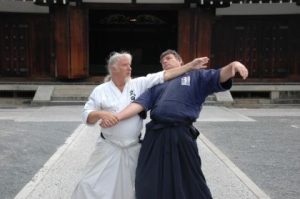
Photos: Demonstration of Takeda Ryu art
Spirit of Takeda Ryu in the words of Grandmaster Maroteaux
Every student of Takeda Ryu must practice the art of his or her choice with a spirit of courtesy and openness instilled by the school. Anyone who does not foster this mental attitude loses the notion of the value of true Budo and cannot aspire to reach the level of consciousness leading to mastery.
The spirit of Takeda Ryu is none other than that of contemporary chivalry, making the one who embodies it a knight of his time. It is therefore out of the question to join the school, hoping to receive much without giving anything. From the outset, every student of Aikijujutsu of Takeda Ryu has the duty to study, in addition to the techniques, which are only means, the human thought in order to harmonise with his fellow men. To achieve this, the study of human thought must be carried out from the point of view of knowledge and action, starting with one’s own. It is therefore above all the fight with oneself and sometimes against oneself, that one must lead. We will then realise that another battle arises daily: that of life.
Every day, man is confronted with various aggressions, mental and, unfortunately, sometimes physical. He must constantly be on the alert in order not to succumb and to face them with peace of mind. The spirit of Takeda Ryu is also the will to always do well what must be done and to act with prudence, conviction, and circumspection. Sincerity is also a major asset to fully succeed in the path of martial arts. It cannot be otherwise since a lie distorts reality and therefore the truth.
As for the techniques of the Takeda Ryu, although they are very old, they are the only means to educate both our body and our mind, forged by the hard training imposed during the courses and internships. Through these means, the body and the mind are made whole, and we can aspire to a level of physical and mental mastery in the face of danger. However, one should not dream, when one knows, that those who reach this state of sublimity are rare and that violence – prohibited in Takeda Ryu – predominates over everything else. To be convinced of this, one only has to read a newspaper, or simply – for what touches us most closely – see the hatred, the jealousy, the vileness, that some martial arts practitioners maintain, more concerned with their own wants, than their own being, with what others do, than with what they themselves do in life.
The spirit and the technique in Takeda Ryu are a whole that is combined in everyday life through the behaviour and not only the word. For example, in Jukenpo (foot/fist form specific to the Takeda Ryu), fluidity favours speed, without sacrificing protection, and resembles kendo without Shinai: same explosion in the engagement, same determination, and same precision. The Aikijujutsu of this school, before being a “way”, is truly a Jutsu based on principles that validate the techniques. Before studying a technique, it is necessary to understand the attitude, to keep one’s centre, to let one’s body evolve to create the “void” necessary for the “absorption” of the opponent. The technique then comes to shorten the response time, not to replace the principle. And the partner who receives must also give, not his roughness but his determination (we are far from “the art of defending oneself against attacks that are not attacks”). There are no games. We don’t do great martial choreographies, where connivance and complicity make fools of some practitioners, who are lucky enough to have never been in a real combat situation. Here, it is not up to Uke to be in harmony with Tori, it is up to tori to harmonize himself with the distances and rhythms that his partner tries to impose through physical constraint. Takeda Ryu Iaido is practised alone and in pairs. At a distance that allows everyone to express themselves in complete safety. It is not about hypnotising oneself in front of a mirror reflecting the image of a satisfied ego. It is not a question of being fast to simply touch. One must adopt a “sharp mind” to be able to cut with a single strike; otherwise, how can one cut with a real sword? However, limiting the expression of budo to combat would be a mistake. The principles of this school are meant to be applied in everyday life. The Takeda Ryu Maroto Ha method invites us to accept others, not out of fear or weakness. Respect and practice of these ancient forms (koryu) are the best guarantors of the perfect transmission of knowledge to future generations.
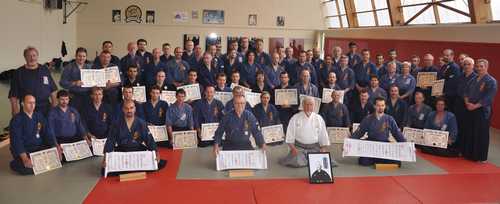
Photo: Grandmaster and instructors of Maroto-Ha School
Maltese dojo
Maltese dojo is led by Okuden Shihan Martin Camilleri (Kyoshi 7th Dan Aikijujutsu, Kyoshi 6th Dan Iaido, 1st Dan Jukenpo, 1st Dan Jodo), who is a senior student of Master Maroteaux. Kyoshi Camilleri was given the school name of Minamoto no Kamiyuri. Kyoshi Camilleri is assisted by Shoden Kyohan Kevin Buhagiar ( Shihan Dai 5th Dan Aikijujutsu, 2nd Dan Iaido, 1st Dan Jukenpo). Kyoshi Camilleri also supervises dojos in other countries, namely in the Czech Republic, Italy, the United Kingdom, and Spain. He also holds the rank of 5th Dan Renshi in Nihon Taijutsu.

